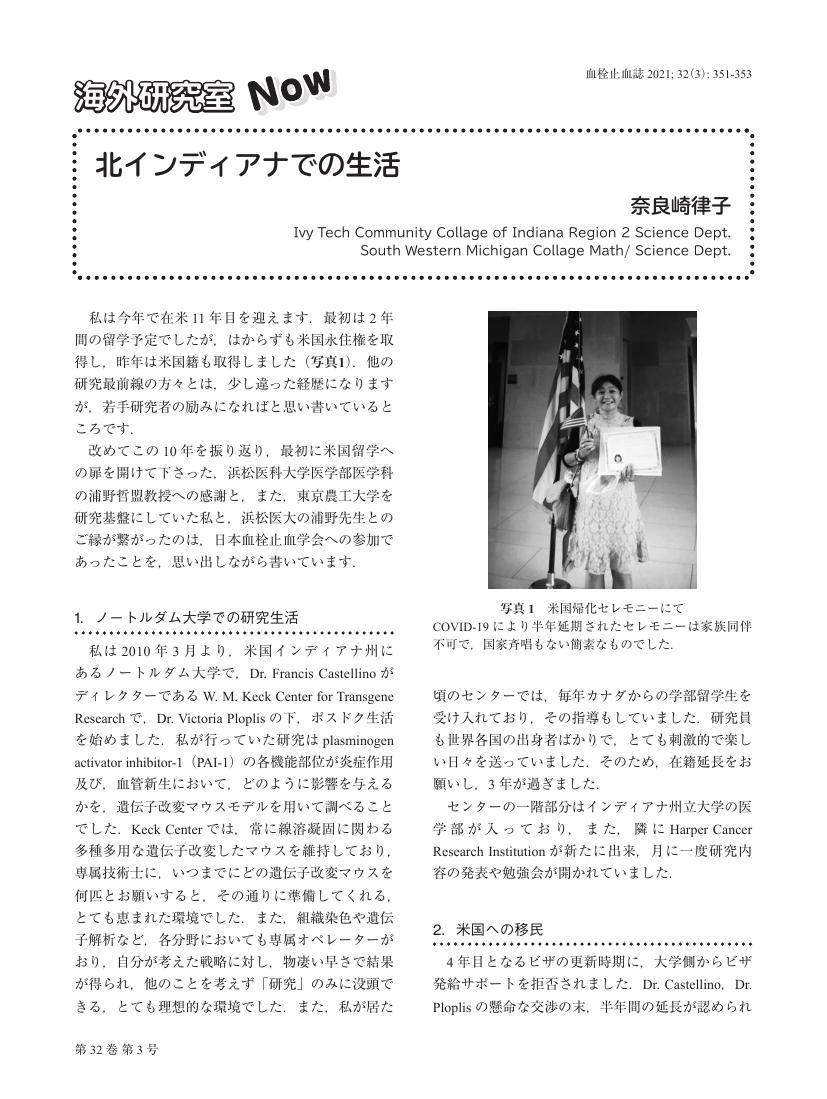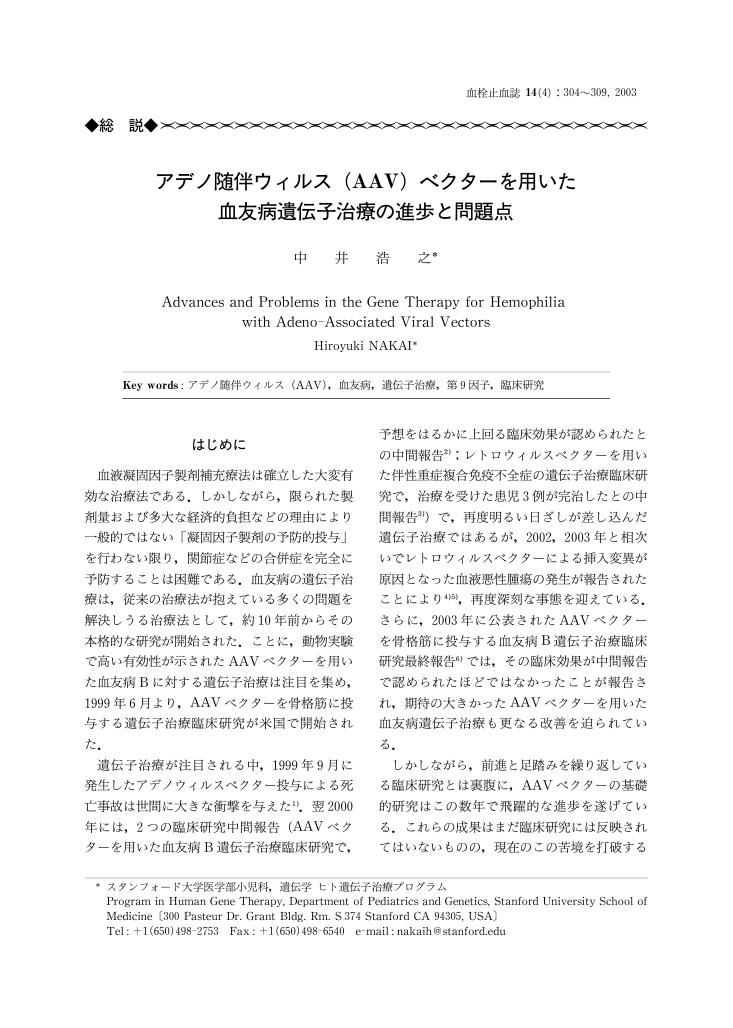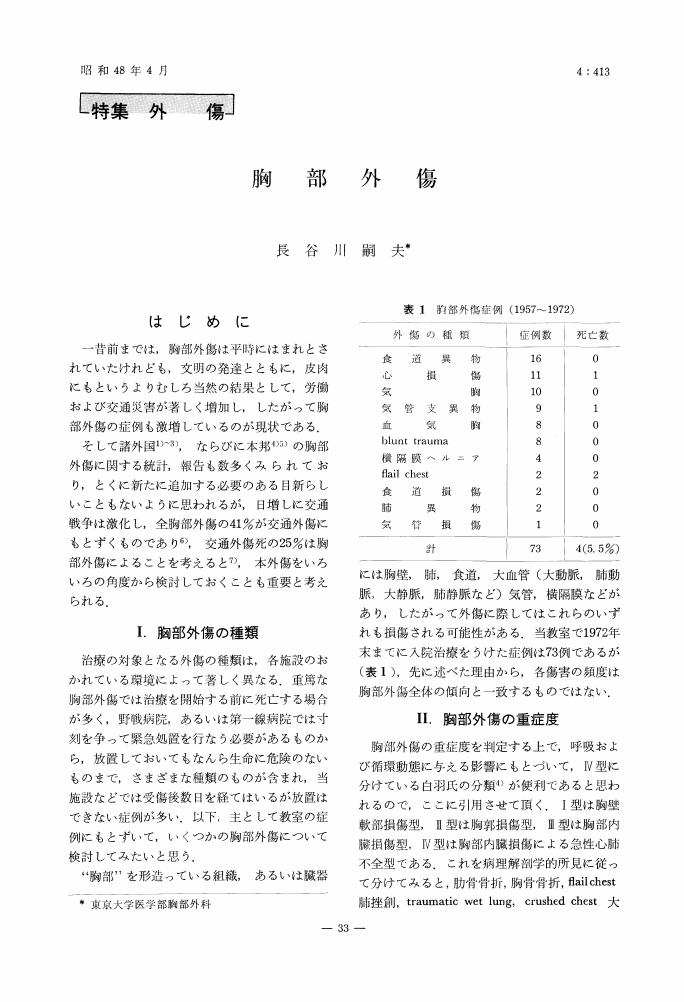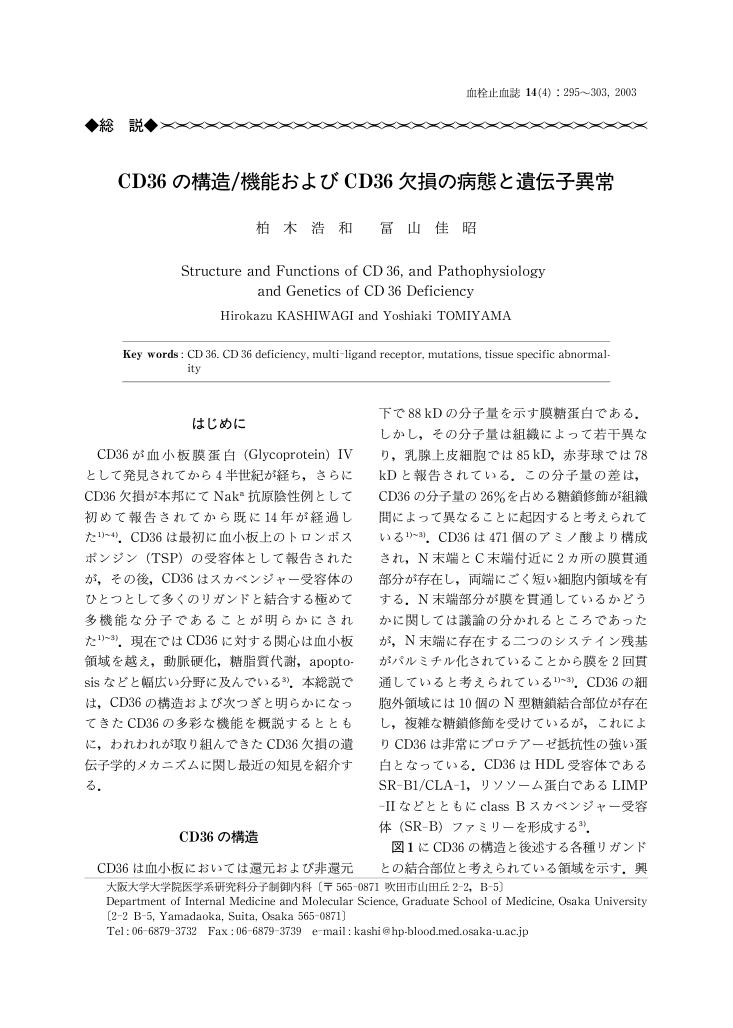1 0 0 0 OA 血液凝固系と補体系のクロストーク
- 著者
- 大隈 浩一 中垣 智弘 岩永 貞昭
- 出版者
- 一般社団法人 日本血栓止血学会
- 雑誌
- 日本血栓止血学会誌 (ISSN:09157441)
- 巻号頁・発行日
- vol.22, no.4, pp.171-185, 2011-08-01 (Released:2011-09-13)
- 参考文献数
- 79
1 0 0 0 OA 深部静脈血栓症の画像診断
- 著者
- 孟 真
- 出版者
- 一般社団法人 日本血栓止血学会
- 雑誌
- 日本血栓止血学会誌 (ISSN:09157441)
- 巻号頁・発行日
- vol.24, no.4, pp.364-369, 2013-08-01 (Released:2013-09-10)
- 参考文献数
- 21
- 被引用文献数
- 1
深部静脈血栓症の診断には客観的な画像診断が不可欠である.現在,超音波診断法とCT静脈造影(CT venography以下CTV)が主に使用されている.超音波診断法は低侵襲で深部静脈血栓症診断の第一選択である.方法はプローブでの圧迫法を基本としてカラードプラ,パルスドプラを併用する.超音波検査は術者の技量・習熟度が検査成績に影響し,下大静脈/腸骨/下腿領域で診断率が下がってしまう.CT肺動脈造影はすでに急性肺塞栓症の第一選択の画像検査である.CT肺動脈造影撮影後にCTVを行うことは早急な診断を要する病態では適している.CTVは下大静脈,腸骨静脈,大腿静脈,膝窩静脈の描出力は高いものの,静脈径の小さい下腿では分解能に限界がある.腎障害,造影剤アレルギー,被曝線量も問題となる.深部静脈血栓症の診断に関しては超音波検査が第一選択であるが,CTVは肺塞栓症合併例や超音波検査困難例などに施設の現状にあわせて超音波診断の相補的な役割を担い,重要性は増している.
1 0 0 0 OA 3.ヘパリン類の適正使用
- 著者
- 辻 肇
- 出版者
- 一般社団法人 日本血栓止血学会
- 雑誌
- 日本血栓止血学会誌 (ISSN:09157441)
- 巻号頁・発行日
- vol.19, no.2, pp.187-190, 2008 (Released:2008-05-01)
- 参考文献数
- 3
- 被引用文献数
- 4 2
Point(1)ヘパリンの使用に際しては,効能・効果,原則禁忌,慎重投与に関する十分な検討を行う.(2)ヘパリンの投与法として,静脈内点滴注射法,静脈内間歇注射法,皮下注射法,筋肉内注射法が知られ,病態に応じて選択する.(3)低分子ヘパリンは,DICの治療,血液体外循環時の灌流血液の凝固阻止に用いられる.(4)ヘパリン類製剤(ダナパロイドナトリウム)は,DICの治療に使用される.
1 0 0 0 OA “ 血” はなぜ固まらないのか?:仮説としての新旧のトロンボモジュリン像
- 著者
- 丸山 征郎
- 出版者
- 一般社団法人 日本血栓止血学会
- 雑誌
- 日本血栓止血学会誌 (ISSN:09157441)
- 巻号頁・発行日
- vol.30, no.5, pp.777-784, 2019 (Released:2019-10-15)
- 参考文献数
- 8
1 0 0 0 OA 北インディアナでの生活
- 著者
- 奈良崎 律子
- 出版者
- 一般社団法人 日本血栓止血学会
- 雑誌
- 日本血栓止血学会誌 (ISSN:09157441)
- 巻号頁・発行日
- vol.32, no.3, pp.351-353, 2021 (Released:2021-06-22)
1 0 0 0 OA ヘパリン起因性血小板減少症における最新の知見
- 著者
- 宮田 茂樹
- 出版者
- 一般社団法人 日本血栓止血学会
- 雑誌
- 日本血栓止血学会誌 (ISSN:09157441)
- 巻号頁・発行日
- vol.23, no.4, pp.362-374, 2012-08-01 (Released:2012-09-03)
- 参考文献数
- 81
- 被引用文献数
- 3 3
1 0 0 0 OA アデノ随伴ウィルス (AAV) ベクターを用いた血友病遺伝子治療の進歩と問題点
- 著者
- 中井 浩之
- 出版者
- 一般社団法人 日本血栓止血学会
- 雑誌
- 日本血栓止血学会誌 (ISSN:09157441)
- 巻号頁・発行日
- vol.14, no.4, pp.304-309, 2003 (Released:2009-03-31)
- 参考文献数
- 23
1 0 0 0 OA 胸部外傷
- 著者
- 長谷川 嗣夫
- 出版者
- 一般社団法人 日本血栓止血学会
- 雑誌
- 血液と脈管 (ISSN:03869717)
- 巻号頁・発行日
- vol.4, no.4, pp.413-419, 1973-04-25 (Released:2010-08-05)
- 参考文献数
- 35
1 0 0 0 OA CD36の構造/機能およびCD36欠損の病態と遺伝子異常
- 著者
- 柏木 浩和 冨山 佳昭
- 出版者
- 一般社団法人 日本血栓止血学会
- 雑誌
- 日本血栓止血学会誌 (ISSN:09157441)
- 巻号頁・発行日
- vol.14, no.4, pp.295-303, 2003 (Released:2009-03-31)
- 参考文献数
- 45
1 0 0 0 OA グリコカリクスが関与する血管内腔の抗血栓性とその障害
- 著者
- 射場 敏明
- 出版者
- 一般社団法人 日本血栓止血学会
- 雑誌
- 日本血栓止血学会誌 (ISSN:09157441)
- 巻号頁・発行日
- vol.27, no.4, pp.444-449, 2016 (Released:2016-08-05)
- 参考文献数
- 22
- 被引用文献数
- 1 1
要約:近年,血管内皮上に存在するグリコカリクス(glycocalyx)の役割が注目されている.プロテオグリカン(proteoglycan)やグリコプロテイン(glycoprotein),糖鎖などからなるこの構造は,血管内腔の血液凝固を抑制しているだけではなく,血小板や好中球の血管内腔への接着を制御したり,血管透過性を調節したり,ずり応力などの力学的刺激を感知するなど,多彩な機能を担っていることが明らかにされてきた.極めて繊細かつ跪弱なグリコカリクスの研究は,技術的課題もあってこれまで十分な進展がみられなかった.しかし最近になって検査手法の進歩にともない,ようやく新しい展開がみられるようになってきた.そしてグリコカリクスは敗血症や虚血再灌流障害といった急性疾患のみならず,糖尿病や動脈硬化などの慢性疾患においても,病態形成においても重要な役割を演じていることが明らかにされた.本稿ではグリコカリクスの構造や機能,疾病との関連などについて最近の知見を紹介する.
1 0 0 0 OA 赤血球寿命測定法
- 著者
- 溝口 秀昭
- 出版者
- 一般社団法人 日本血栓止血学会
- 雑誌
- 血液と脈管 (ISSN:03869717)
- 巻号頁・発行日
- vol.3, no.11, pp.1211-1212, 1972-11-25 (Released:2010-08-10)
- 参考文献数
- 2
1 0 0 0 老人ホーム在住者の凝固線溶能の経年変化
- 著者
- 松田 保 小河原 緑 三浦 玲子 関 俊子
- 出版者
- 一般社団法人 日本血栓止血学会
- 雑誌
- 血液と脈管 (ISSN:03869717)
- 巻号頁・発行日
- vol.15, no.2, pp.207-209, 1984
- 被引用文献数
- 1
Levels of fibrinogen, plasminogen, antithrombin III, α<sub>2</sub>-plasmin inhibitor and α<sub>2</sub>-macroglobulin in plasma were determined using single radial immunodiff usion method in an old people's home in 1979, 1981 and 1982. Comparison of results of these parameters in the same subjects between in 1981 and 1982 was possible in 67 subjects. Comparison between in 1979 and 1981 was done in 61 subjects. Results of coagulation analysis in 1979 and 1982 were compared in 49 subjects.<br>Generally, concentrations of plasminogen, antithrombin III and α<sub>2</sub>-plasmin inhibitor in plasma were higher in women than in men. There were statistically significant correlations between all the parameters determined at intervals of 1, 2 and 3 years in the same subjects. The coefficients of correlation in each parameter at intervals of 1 to 3 years were as follows: +0.45-+0.57 in fibrinogen, +0.69-+0.81 in plasminogen, +0.55-+0.81 in antithrombin III, +0.46-+0.64 in α<sub>2</sub>-plasmin inhibitor and +0.91-+0.93 in alpha;<sub>2</sub>-macroglobulin. From these results, it is concluded that old women are generally less thrombotic than old men and that there is some “individuality” in patterns of the parameters affecting blood coagulation and fibrinolysis in the elderly. The significance of the “individuality” upon prognosis of the elderly was discussed.
1 0 0 0 血管内凝固症候群とショック
- 著者
- 松田 保 小河原 緑 平林 直子 関 俊子 横内 正利 村上 元孝 島田 馨 三船 順一郎
- 出版者
- 一般社団法人 日本血栓止血学会
- 雑誌
- 血液と脈管 (ISSN:03869717)
- 巻号頁・発行日
- vol.9, no.2, pp.208-212, 1978
Recently, growing interests had been devoted largely to disseminated intravascular coagulation (DIC), because of its frequency and clinical importance. It has been known that shock is a frequent complication of DIC, although it has not been elucidated whether shock is a cause of DIC rather than a result. This study was made to clarify relationship between DIC and shock in 699 consecutive autopsied cases, almost all of whom was over age sixty, in Tokyo Metropolitan Geriatric Hospital.<br>The diagnosis of DIC was established when coagulation analysis revealed presence of consumption coagulopathy. Among these cases, 106 had evidences of DIC and 30 had clinical and pathological findings highly suggestive of DIC although the coagulation findings were not specific. Shock was complicated in 38 of the former and 10 of the latter.<br>Eight of these 48 patients with DIC complicated with shock revealed consumption coagulopathy simultaneously with the development of shock. 24 cases had not clea r-cut evidences of DIC immediately after the development of shock in coagulation findings, although they showed marked coagulation abnormalities indicating DIC after the shock developed. 44% of conditions associated with the shock in these patients was gram-negative septicaemia. The other underlying pathologic conditons in these cases consisted of cancer, peptic ulcer, acute myocardial infarction and pneumonia.<br>Onset of shock was observed in 16 cases in whom diagnosis of DIC had been already established by coagulation analysis. 11 cases of these had cancer with metastases, primary organs of which were stomach, colon or biliary tracts. 70% of these patients were febrile.<br>Acute renal failure, purpura, petechiae, melena, coma, epileptic seizure, systemic peripheral gangrene and/or red cell fragmentation in peripheral blood smear were main symptoms in DIC with shock. Four cases, excluding two cases in whom DIC developed following development of acute myocardial infarction, showed ECG findings indicating development of acute myocardial infartion, although myocardial infarction was evident in only one cases by postmortem examination.<br>Presence of fibrin thrombi was confirmed in 36 cases out of the 48 autopsied cases with DIC accompained with shock. Terminal hemorrhagic necrotizing enteropathy was observed in 15 of those cases. Hemorrhage from adrenal was observed in 4 cases.<br>From these results, it is concluded that shock does frequently cause DIC and that shock in gram-negative septicaemia is especially important because of its high incidence to result DIC.
1 0 0 0 Hypercoagulability と血栓
- 著者
- 松田 保
- 出版者
- 一般社団法人 日本血栓止血学会
- 雑誌
- 血液と脈管 (ISSN:03869717)
- 巻号頁・発行日
- vol.1, no.4, pp.485-495, 1970
1 0 0 0 老年者の血液粘度
- 著者
- 松田 保 児玉 直子 秀野 啓子 小河原 緑 松崎 俊久 村上 元孝 山之内 博
- 出版者
- 一般社団法人 日本血栓止血学会
- 雑誌
- 血液と脈管 (ISSN:03869717)
- 巻号頁・発行日
- vol.7, no.2, pp.146-150, 1976
Apparent blood viscosity was measured on freshly shed blood from 127 healthy subjects, ages 21 to 88, and patients hospitalized in Tokyo Metropolitan Yoikuin Geriatrics Hospital, over age 60. Determination of blood viscosity was performed at 37°C using rotational viscometer at shear rates between 0.07 and 4.6sec<sup>-1</sup>.<br>Mean blood viscosity in 43 healthy older subjects over age 60 (mean age: 74±6) was 45±25cp at 0.07sec<sup>-1</sup> and 8±2cp at 4.6sec<sup>-1</sup>, respectively. Yield stress was calculated from Casson plot at very low shear rates (between 0.44 and 0.07sec<sup>-1</sup>) by the method of least squares. Mean value of yield stress in the healthy older subjects was 0.011 dynes/cm<sup>2</sup>. Blood viscosity in the healthy subjects was significantly correlated with hematocrit values. Yield stress in these subjects was also correlated with hematocrit values and blood viscosity at very low shear rates. In these healthy subjects, blood viscosity, yield stress and hematocrit values were highest in the group at age 30-39. Blood viscosity and yield stress showed a slight decline with age in the healthy older subjects.<br>In the hospitalized patients, blood viscosity was higher than 70cp at 0.07sec<sup>-1</sup>, and/or higher than 11cp at 4.6sec<sup>-1</sup> in 107 measurements (86 cases) out of 1443 determinations from December 1973 to October 1974. These patients with blood high viscosity included 12 cases of cancer (one of them was accompanied with disseminated intravascular coagulation (DIC); three of them developed DIC thereafter), 5 cases of acute myocardial infarction, 4 cases of acute cerebral infarction, 5 cases of angina pectoris, 6 cases of old myocardial infarction, 18 cases of old cerebrovascular diseases, 11 cases of diabetes mellitus, and 5 cases of stress polycythemia or polycythemia vera. In these cases, viscosity at 4.6sec<sup>-1</sup> was significantly correlated with hematocrit values, whereas viscosity at 0.07sec<sup>-1</sup> was not. All patients with blood high viscosity and relatively low hematocrit values suffered from cancer. In 6 cases of acute myocardial, cerebral of renal infarction, in whom changes in blood viscosity, yield stress and hematocrits were investigated before and after the development of infarction, changes in blood viscosity and yield stress were parallel with hematocrits.<br>From these results, it was concluded that high hematocrits caused blood high viscosity and were regarded as one of the risk factors in the pathogenesis of thrombosis, although the other factors than hematocrits might also influence blood viscosity at very low shear rates.
1 0 0 0 血液粘度の低温における変化とその意義
- 著者
- 松田 保 小河原 緑 三浦 玲子 関 俊子 横内 正利
- 出版者
- 一般社団法人 日本血栓止血学会
- 雑誌
- 血液と脈管 (ISSN:03869717)
- 巻号頁・発行日
- vol.12, no.1, pp.13-15, 1981
Viscosity of blood at 37°C and 25°C was compared in various blood samples using coaxial cylinder viscometer which operates on the couette principle. Ratios of blood viscosity measured at 25°C to one at 37°C at shear rate of 0.39sec<sup>-1</sup> were significantly correlated with fibrinogen content of blood (n=49, r=+0.62, p<0.001). However, there was no significant correlation between ratios of blood viscosity at body temperature to one at the lower temperature and hematocrit values (n=49, r=-0.22, n. s.). To confirm important role of fibrinogen in elevation of blood viscosity when temperature falls, following experiment was carried out. Red blood cell suspentions with various amount of fibrinogen were prepared from combinations of packed red cells, bentonite adsorbed plasma, which contains no fibrinogen, normal plasma and human fibrinogen solution. Elevation of viscosity at 25°C was more pronounced when amount of fibrinogen in the suspension increased.<br>Significance of elevated viscosity of blood with increased fibrinogen content at low temperature in development of Raynaud's phenomenon was discussed.
1 0 0 0 Ellagic acid の凝血・線溶系に及ぼす影響
- 著者
- 村上 元孝 松田 保 万見 新太郎 平丸 三樹 大江 国広
- 出版者
- 一般社団法人 日本血栓止血学会
- 雑誌
- 血液と脈管 (ISSN:03869717)
- 巻号頁・発行日
- vol.1, no.6, pp.857-864, 1970
1 0 0 0 Trasylol の線溶・凝血系に及ぼす影響
- 著者
- 村上 元孝 松田 保 万見 新太郎 平丸 三樹
- 出版者
- 一般社団法人 日本血栓止血学会
- 雑誌
- 血液と脈管 (ISSN:03869717)
- 巻号頁・発行日
- vol.2, no.3, pp.411-417, 1971
1 0 0 0 ボストン留学記
- 著者
- 森下 英理子
- 出版者
- 一般社団法人 日本血栓止血学会
- 雑誌
- 日本血栓止血学会誌 (ISSN:09157441)
- 巻号頁・発行日
- vol.27, no.6, pp.694-696, 2016
1 0 0 0 OA 間葉系幹細胞からの血小板創製技術の医療応用研究
- 著者
- 松原 由美子
- 出版者
- 一般社団法人 日本血栓止血学会
- 雑誌
- 日本血栓止血学会誌 (ISSN:09157441)
- 巻号頁・発行日
- vol.31, no.4, pp.432-438, 2020 (Released:2020-08-12)
- 参考文献数
- 13
Platelets are released from mature megakaryocytes (MKs) and are used for therapeutic application, especially platelet transfusion. Platelet concentrates used for platelet transfusions are currently supplied by volunteer donors. Due to their short shelf life (4 days in Japan and 5 days in US), however, donor-dependent platelet concentrates are associated with practical problems, such as the limited supply and the risk of infection. Thus, new strategies for manufacturing MKs and subsequently platelets from a donor-independent source are urgently needed. Mesenchymal stem cells (MSCs) are known to be non-hematopoietic multipotent progenitor-cells. We found that MSCs/stromal cells differentiated into MKs and platelets. The clinical needs for platelet transfusions are increasing. Adipose tissue-derived MSCs/stromal cells are an attractive candidate cell source because inducing these cells into MK-lineages requires no gene transfer and only endogenous transcription factors containing p45NF-E2/Maf, an MK-inducing factor and endogenous thrombopoietin, a primary cytokine that drives MK lineages. Thus, we developed a manufacturing system for platelets from donor-independent cell source, human adipose-derived mesenchymal stromal/stem cell line (ASCL). ASCL satisfied the minimal criteria for defining MSC by The International Society for Cellular Therapy. ASCL-derived platelets (ASCL-PLT) were obtained with a peak at Day 12 of culture using MK lineage induction media. We observed that CD42b-positive cells expressed a MSC marker CD90 in relation to cell adhesion. The pattern of in vivo kinetics after being infused into irradiated immunodeficient NSG mice was similar to that of platelet concentrates. ASCL-PLT has characterization observed in other platelet populations and might have additional function as MSC. The present protocol is a simple method that requires no feeder cells, further enhancing the clinical application of our approach.







